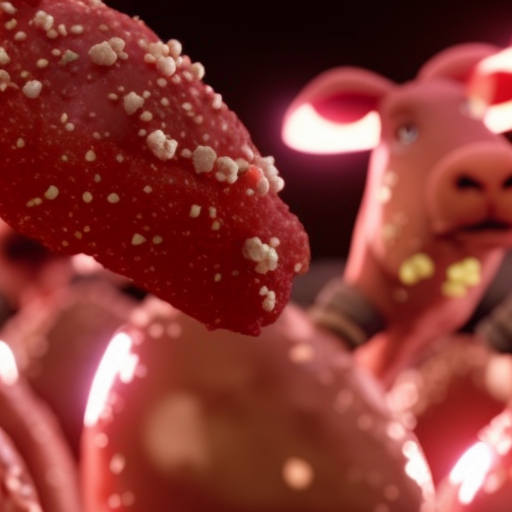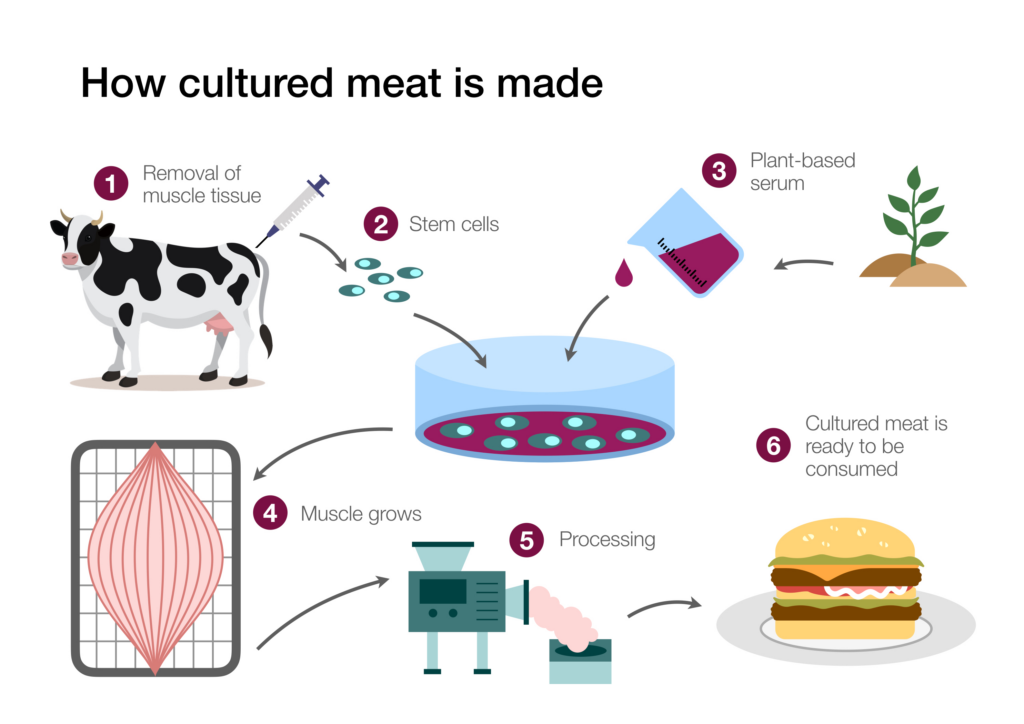
Lab Meat: A Sustainable Solution for Meat Production
It’s the quintessential meat lover’s dish and a holiday favorite, popularized by sportscaster John Madden and Cajun chef Paul Prudhomme.
Turducken: A Meat Lover’s Delight
Turducken, a blended word combining turkey, duck, and chicken, consists of a deboned chicken stuffed into a deboned duck that, in turn, is stuffed into a deboned turkey. The cavity of the chicken and the gaps between the birds is filled with a bread crumb and sausage mixture. Alternatively, some cooks add pork or veal roast to the chicken cavity instead of traditional stuffing.
Turducken epitomizes our love affair with meat and demonstrates that there is no distance a true meat lover won’t traverse to satisfy his or her cravings. More and more people around the world are becoming meat lovers. But this love affair may not last long because many experts believe that the world’s meat producers won’t have the wherewithal to satisfy the ever-increasing demand.
The Sustainable Development Goals (SDGs) and Meat Production
Global Growth of the Demand for Meat
- The yearning for meat (and other animal products such as milk and eggs) has grown worldwide. In 1960, 71 million tons of meat was produced (and consumed), globally. By 2022, that number had swelled to 340 million tons. Some projections put global meat production between 460 million and 570 million tons by 2050.
The increased demand for meat is due to two main factors: (1) a growing worldwide human population, and (2) increased affluence in the developing world. As people acquire more wealth, their diets include more meat. At this current pace, there’s a growing concern that farmers won’t have the production capacity to satisfy the worldwide demand.
Environmental Impact of Meat Production
- Another problem concerns the now widely held belief that the growing demand for meat will inevitably cause increasing harm to the environment.
By some estimates, animal agriculture generates about 18% of the worldwide greenhouse gas emissions. Waste from animal agriculture also leaches into water supplies, particularly when a lot of animals are raised in a concentrated space. This waste runoff creates dead zones in the affected water supplies.
Animal agriculture also requires extensive land use. The increased demand for meat has become one of the drivers of deforestation. According to some estimates, about 1 acre of forest land is cleared every second. And much of it is used for animal agriculture. About 91% of the deforested land of the Amazon rainforest is now used to raise livestock for meat production.
Land use for meat production is inefficient. The amount of land it takes to produce a gram of edible beef protein is about 20 times greater than what it takes to produce a gram of edible proteins from beans and lentils.
In the US, 67% of the crops produced on farmland goes to feed animals raised for meat production. Only 27% of crop production provides calories directly consumed by human beings. In addition, half of the water used in the US is for animal agriculture.
In short, animal agriculture puts a strain on limited natural resources and causes environmental damage. This strain and damage will only get worse as more and more people consume meat.
Meat Production and Animal Cruelty
- There’s also an ethical dimension to the increased global demand for meat. To sustain the current demand, around 70 billion land animals and trillions of marine animals are slaughtered each year. The most efficient way to grow this number of animals is through factory farming, which many people find to be cruel and inhumane.
Lab Meat as an Alternative
- In the face of the limited resources available to increase meat production, concerns for the environment, and concerns about animal welfare, some biotechnologists are exploring another option: the production of meat in the laboratory from stem cells.
Advocates claim that lab meat would be friendlier to the environment than factory farming and would bring an end to the cruelty of factory farming. And it could help supply the world’s growing desire to consume more meat with a healthier, more versatile product than meat produced from animal agriculture.
Thanks to advances in synthetic biology and tissue engineering, researchers can now “grow” meat in the laboratory from a few stem cells recovered from tissue biopsies taken from animals. This lab-grown tissue is called lab meat, cultured meat, or synthetic meat. But most advocates prefer the less unpleasant label, clean meat.
Growing Meat in the Lab
A source of stem cells is required to grow meat in the lab. Because stem cells can be cultured into “immortal” cell lines, once established, the cell line can serve as an ongoing source of cells for meat production. Estimates communicated in popular media outlets routinely claim that one biopsy could generate tons of meat products. More measured estimates indicate that with current technology, lab meat production will dramatically reduce the number of animals required for meat production, but not to the extent popularly claimed. A recent study focusing on beef indicated that wide-scale lab meat production could reduce the number of cattle needed to produce beef globally by a factor of four hundred. By optimizing the biopsy process and improving the efficiency of stem and progenitor cell recovery from the biopsies, researchers hope the advances could lead to an even greater reduction in animals used for meat production.
Investigators have tried several different types of stem cells to culture meat, and the most promising have been muscle stem cells (called myosatellite cells). These cells are humanely isolated by taking a muscle biopsy from an anesthetized animal, causing the creature minimal discomfort. Once the tissue biopsy has been secured, the structure of the tissue is disrupted by an enzymatic treatment. The tissue disruption frees the cells from other tissue components, making it easier to isolate and recover them.
Figure 1: The Growth of Meat in the Lab

Figure 2: The Growth of Muscle Fibers from Myosatellite Cells

SDGs, Targets, and Indicators
SDGs Addressed in the Article:
- SDG 2: Zero Hunger
- SDG 3: Good Health and Well-being
- SDG 8: Decent Work and Economic Growth
- SDG 12: Responsible Consumption and Production
- SDG 13: Climate Action
- SDG 15: Life on Land
Specific Targets Based on the Article’s Content:
- Target 2.1: By 2030, end hunger and ensure access by all people, in particular the poor and people in vulnerable situations, including infants, to safe, nutritious, and sufficient food all year round.
- Target 3.9: By 2030, substantially reduce the number of deaths and illnesses from hazardous chemicals and air, water, and soil pollution and contamination.
- Target 8.5: By 2030, achieve full and productive employment and decent work for all women and men, including for young people and persons with disabilities, and equal pay for work of equal value.
- Target 12.2: By 2030, achieve the sustainable management and efficient use of natural resources.
- Target 13.2: Integrate climate change measures into national policies, strategies, and planning.
- Target 15.2: By 2020, promote the implementation of sustainable management of all types of forests, halt deforestation, restore degraded forests, and substantially increase afforestation and reforestation globally.
Indicators Mentioned or Implied in the Article:
- Indicator 2.1.1: Prevalence of undernourishment
- Indicator 3.9.1: Mortality rate attributed to household and ambient air pollution
- Indicator 8.5.1: Average hourly earnings of female and male employees, by occupation, age, and persons with disabilities
- Indicator 12.2.1: Material footprint, material footprint per capita, and material footprint per GDP
- Indicator 13.2.1: Number of countries that have communicated the strengthening of institutional, systemic, and individual capacity-building to implement adaptation, mitigation, and technology transfer
- Indicator 15.2.1: Progress towards sustainable forest management
Table: SDGs, Targets, and Indicators
| SDGs | Targets | Indicators |
|---|---|---|
| SDG 2: Zero Hunger | Target 2.1: By 2030, end hunger and ensure access by all people, in particular the poor and people in vulnerable situations, including infants, to safe, nutritious, and sufficient food all year round. | Indicator 2.1.1: Prevalence of undernourishment |
| SDG 3: Good Health and Well-being | Target 3.9: By 2030, substantially reduce the number of deaths and illnesses from hazardous chemicals and air, water, and soil pollution and contamination. | Indicator 3.9.1: Mortality rate attributed to household and ambient air pollution |
| SDG 8: Decent Work and Economic Growth | Target 8.5: By 2030, achieve full and productive employment and decent work for all women and men, including for young people and persons with disabilities, and equal pay for work of equal value. | Indicator 8.5.1: Average hourly earnings of female and male employees, by occupation, age, and persons with disabilities |
| SDG 12: Responsible Consumption and Production | Target 12.2: By 2030, achieve the sustainable management and efficient use of natural resources. | Indicator 12.2.1: Material footprint, material footprint per capita, and material footprint per GDP |
| SDG 13: Climate Action | Target 13.2: Integrate climate change measures into national policies, strategies, and planning. | Indicator 13.2.1: Number of countries that have communicated the strengthening of institutional, systemic, and individual capacity-building to implement adaptation, mitigation, and technology transfer |
| SDG 15: Life on Land | Target 15.2: By 2020, promote the implementation of sustainable management of all types of forests, halt deforestation, restore degraded forests, and substantially increase afforestation and reforestation globally. | Indicator 15.2.1: Progress towards sustainable forest management |
Behold! This splendid article springs forth from the wellspring of knowledge, shaped by a wondrous proprietary AI technology that delved into a vast ocean of data, illuminating the path towards the Sustainable Development Goals. Remember that all rights are reserved by SDG Investors LLC, empowering us to champion progress together.
Source: reasons.org

Join us, as fellow seekers of change, on a transformative journey at https://sdgtalks.ai/welcome, where you can become a member and actively contribute to shaping a brighter future.






